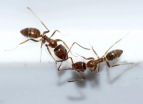(Press-News.org) In a new study published in the Protein & Cell, Chen-Yu Zhang's group at Nanjing University reports that small non-coding RNAs in maternal food can transfer through placenta to regulate fetal gene expression.
MicroRNAs (miRNA) are a class of noncoding RNAs with lengths of approximately 22 nucleotides that bind to target messenger RNAs to inhibit protein translation. In previous studies, the same group has found that plant miRNAs can enter into the host blood and tissues via the route of food-intake. The food-derived exogenous miRNAs are absorbed, packaged into microvesical (MV) and then secreted into circulation by cells of animal GI tract. More importantly, once inside the host, the food-derived exogenous miRNAs can regulate host physiology by regulating host "target" genes in the cross-kingdom manner. In support of this new concept, they have also found a plant microRNA, MIR2911, which is enriched in honeysuckle, directly targets influenza A viruses (IAV) including H1N1, H5N1 and H7N9. Drinking of honeysuckle soup can prevent IAV infection and reduce H5N1-induced mice death.
Here, they report another surprising finding that exogenous plant miRNAs and artificial synthetic small influence RNAs (siRNAs) can transfer through the placenta and directly regulate fetus gene expression. Firstly, exogenous plant miRNAs was detected in human umbilical cord blood, amniotic fluid as well as animal foetuses with certain level. When pregnant mice were administrated honeysuckle soup (the exogenous plant microRNAs are physiological concentration in food), the plant MIR2911 was detected in fetus liver with significant level. Finally, feeding pregnant mice with synthetic alpha-fetoprotein (AFP, only expressed in foetus liver) siRNA decreased significantly AFP mRNA and protein levels. They have further demonstrated that MV- driven small RNAs are able to pass through placenta.
This work is important for the following reasons:
1) This is the first time to demonstrate that small RNAs can pass through mammalian placenta and directly regulate foetus gene, consequently may also influence foetus development. It's well known that the placenta is a vital organ on which the survival and growth of the foetus are critically dependent. It forms the interface between the maternal and foetal environments, facilitating the exchange of gases, nutrients and waste products between the mother and baby, and also acts as a barrier against the maternal immune system. "The classical concept is that nucleic acid is not able to pass through the mammalian placenta, while we have also demonstrated that MV- driven small RNAs are able to pass through placenta", Zhang said. This discovery is obviously important to understand further the function of placenta and maternal and foetal environments.
2) Exogenous small RNAs in food not only affect pregnant female, but influence foetus development as well. The dietary patterns of the mother will influence the foetus or even determine the postnatal health status. Dietary bias or other unhealthy dietary habits would also affect the foetus health by disrupting the balance of transplacental miRNAs or even cause a foetus - origin adult disease.
3) This finding also reveals the possibility that maternal small-noncoding RNAs participate in fetal epigenetic regulation during pregnancy. Thus, the pathological status of the mother will result in an abnormal endogenous miRNA profile per se, which will also influence foetal health.
"According to what I know, this is the first study to examine the transplacental transmission of small-noncoding RNAs." Professor Yali Hu said, who is an expert of department of Obstetrics and Gynecology, Nanjing Drum Tower Hospital. "This finding also proposes a brand new potential strategy to treat fetal diseases in utero. Given that artificial synthetic siRNAs can transfer through placenta, we can try to use gene therapy to treat fetal disease by maternal administration." Hu said.
INFORMATION:
The researchers of this project include Jingli#, Yujing Zhang #, Dameng Li, Yuchen Liu, Danping Chu, Xiaohong Jiang, Dongxia Hou, Ke Zen*, Chen-Yu Zhang* of State Key Laboratory of Pharmaceutical Biotechnology, Nanjing Advanced Institute for Life Sciences (NAILS), Nanjing University School of Life Sciences, Jiangsu Engineering Research Center for MicroRNA Biology and Biotechnology, 22 Hankou Road, Nanjing, Jiangsu 210093, China.
This work was supported by the National Basic Research Program for China (973 Program; 2014CB542300), the National Science Foundation of China (31200874, 31200969, 81101330, 31271378 and 81250044), and the Research Fund for the Doctoral Program of Higher Education of China (20120091120044).
Li et al.: "Small non-coding RNAs transfer through mammalian placenta and directly regulate fetal gene expression" Publishing on Protein & Cell.
Author contact: Chen-Yu Zhang (Jiangsu Engineering Research Center for MicroRNA Biology and Biotechnology, State Key Laboratory of Pharmaceutical Biotechnology, Nanjing Advanced Institute for Life Sciences (NAILS), School of Life Sciences, Nanjing University 22 Hankou Road, Nanjing, Jiangsu 210093, China.)
Tel: +86 25 8368 0245; E-mail: cyzhang@nju.edu.cn
WASHINGTON, DC -- May 12, 2015-- A multidisciplinary group of US-based researchers has shown that the mixture of species found within natural bacterial communities in the environment can accurately predict the presence of contaminants such as uranium, nitrate, and oil. The findings, published this week in mBio, the online open-access journal of the American Society for Microbiology, show that the rapid sequencing of microbiomes in place at environmental sites can be used to monitor damage caused by human activity.
"This approach might be a general way for us to see anthropogenic ...
Nerve cells that produce dopamine for the purpose of transmitting signals to other cells affect numerous crucial brain functions. This becomes evident in diseases such as Parkinson's and schizophrenia, where dopamine transmission in the brain is impaired. In collaboration with researchers from Bonn, RUB scientists at the Mercator Research Group "Structure of Memory" have now identified in what way a specific form of this important cell is generated and which networks it forms in the course of brain development. In the process, the researchers discovered a data highway of ...
Amsterdam, May 12, 2015 - Wearable E-skin that can measure heart rate and blood pressure, and paper diagnostic machines the size of a credit card that can give instant readings on blood and saliva samples are two new bio-sensing technologies presented at Elsevier's 4th International Conference on Bio-Sensing Technology in Lisbon, Portugal on 12 May 2015.
Bio-sensors can detect and analyze data to give patients information on their heart rate and blood pressure, blood sugar and hormone levels, and even test whether they are infected with antibiotic-resistant bacteria. ...
SAN FRANCISCO, CA--MAY 11, 2015--Scientists have discovered a way to regrow bone tissue using the protein signals produced by stem cells. This technology could help treat victims who have experienced major trauma to a limb, like soldiers wounded in combat or casualties of a natural disaster. The new method improves on older therapies by providing a sustainable source for fresh tissue and reducing the risk of tumor formation that can arise with stem cell transplants.
The new study, published in Scientific Reports, is is the first to extract the necessary bone-producing ...
First there were canaries in coal mines, now there are microbes at nuclear waste sites, oil spills and other contaminated environments. A multi-institutional team of more than 30 scientists has found that statistical analysis of DNA from natural microbial communities can be used to accurately identify environmental contaminants and serve as quantitative geochemical biosensors. This study was sponsored by ENIGMA, a U.S. Department of Energy (DOE) Office of Science "Scientific Focus Area Program" based at the Lawrence Berkeley National Laboratory (Berkeley Lab).
"Changes ...
Researchers at Case Western Reserve University combined finely crafted nanoparticles with one of nature's potent disrupters to prevent the spread of triple-negative breast cancer in mouse models.
The highly aggressive cancer subtype is difficult to manage and, currently, the FDA has no approved targeted treatments. But striking results from a new study, published in the journal Cancer Research make the researchers optimistic they have a potential game-changer for triple negative cancer and more.
"There are multiple targets within a cell," said William Schiemann, professor ...
Pregnant women who exercise can significantly lower the risk of undergoing Caesarean sections and giving birth to large babies, a University of Alberta study has found.
Prenatal exercise has been suggested to be a means to prevent childhood obesity through a "normalization" in birth weight (ie. reducing the risk of having a large baby at birth). University of Alberta researchers conducted a meta-analysis to analyze 28 randomized control studies encompassing 5,322 women that looked at the influence of maternal exercise on baby outcomes.
"We found that women who exercised ...
In a study that compared three sites within the Dja Conservation Complex in Cameroon, Africa, investigators found that the presence of a conservation research project acts as a deterrent to chimpanzee and gorilla poachers, and community awareness and involvement in research lead to an increased value of apes and intact forests to local people, thus limiting hunting practices.
The results provide evidence that the mere existence of research programs exerts a positive impact on the conservation of wildlife in their natural habitats.
"It's important to recognize the effectiveness ...
Mass shootings at the hands of unhinged loners - such as those in Aurora, Colorado; Santa Barbara, California, and Newtown, Connecticut - perpetuate a commonly held belief that mental illness triggers violent crimes.
But a new study from the University of California, Berkeley, shows that hallucinations and delusions associated with psychiatric disorders seldom foreshadow acts of aggression.
In a painstaking review of 305 violent incidents in the United States, the researchers found that only 12 percent were preceded by psychosis. While numerous studies have found that ...
When ants go exploring in search of food they end up choosing collective routes that fit statistical distributions of probability. This has been demonstrated by a team of mathematicians after analysing the trails of a species of Argentine ant. Studies like this could be applied to coordinate the movement of micro-robots in cleaning contaminated areas for example.
Scientists have yet to discover the mechanisms explaining how flocks of birds, shoals of fish, lines of ants and other complex natural systems organise themselves so well when moving collectively.
To tackle ...

